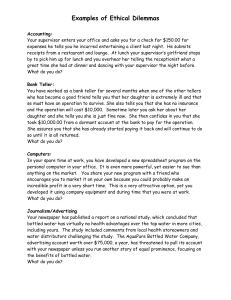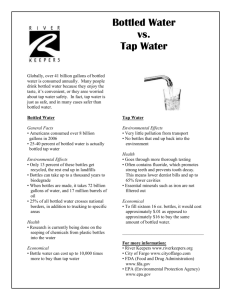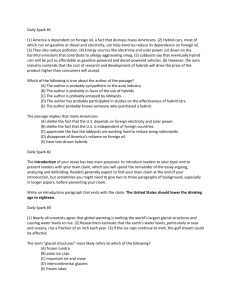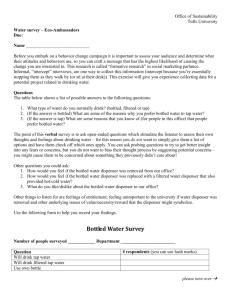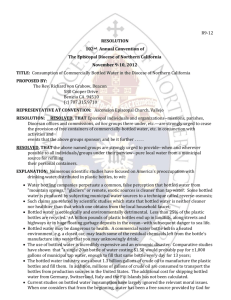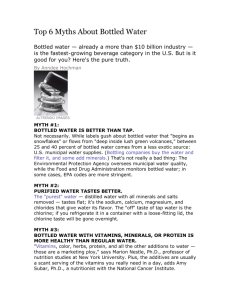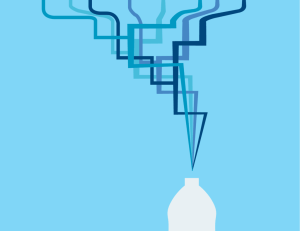Bottle of water or billion dollar bully?
advertisement
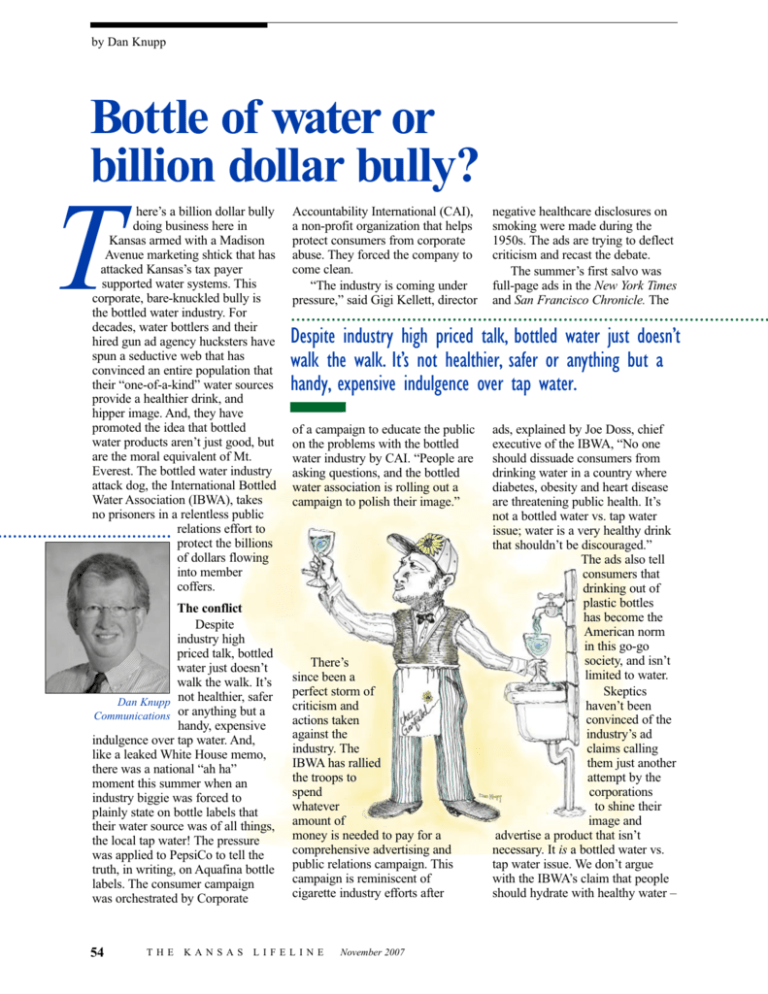
by Dan Knupp Bottle of water or billion dollar bully? T here’s a billion dollar bully doing business here in Kansas armed with a Madison Avenue marketing shtick that has attacked Kansas’s tax payer supported water systems. This corporate, bare-knuckled bully is the bottled water industry. For decades, water bottlers and their hired gun ad agency hucksters have spun a seductive web that has convinced an entire population that their “one-of-a-kind” water sources provide a healthier drink, and hipper image. And, they have promoted the idea that bottled water products aren’t just good, but are the moral equivalent of Mt. Everest. The bottled water industry attack dog, the International Bottled Water Association (IBWA), takes no prisoners in a relentless public relations effort to protect the billions of dollars flowing into member coffers. The conflict Despite industry high priced talk, bottled water just doesn’t walk the walk. It’s Dan Knupp not healthier, safer Communications or anything but a handy, expensive indulgence over tap water. And, like a leaked White House memo, there was a national “ah ha” moment this summer when an industry biggie was forced to plainly state on bottle labels that their water source was of all things, the local tap water! The pressure was applied to PepsiCo to tell the truth, in writing, on Aquafina bottle labels. The consumer campaign was orchestrated by Corporate 54 THE KANSAS Accountability International (CAI), a non-profit organization that helps protect consumers from corporate abuse. They forced the company to come clean. “The industry is coming under pressure,” said Gigi Kellett, director negative healthcare disclosures on smoking were made during the 1950s. The ads are trying to deflect criticism and recast the debate. The summer’s first salvo was full-page ads in the New York Times and San Francisco Chronicle. The Despite industry high priced talk, bottled water just doesn’t walk the walk. It’s not healthier, safer or anything but a handy, expensive indulgence over tap water. of a campaign to educate the public on the problems with the bottled water industry by CAI. “People are asking questions, and the bottled water association is rolling out a campaign to polish their image.” There’s since been a perfect storm of criticism and actions taken against the industry. The IBWA has rallied the troops to spend whatever amount of money is needed to pay for a comprehensive advertising and public relations campaign. This campaign is reminiscent of cigarette industry efforts after LIFELINE November 2007 ads, explained by Joe Doss, chief executive of the IBWA, “No one should dissuade consumers from drinking water in a country where diabetes, obesity and heart disease are threatening public health. It’s not a bottled water vs. tap water issue; water is a very healthy drink that shouldn’t be discouraged.” The ads also tell consumers that drinking out of plastic bottles has become the American norm in this go-go society, and isn’t limited to water. Skeptics haven’t been convinced of the industry’s ad claims calling them just another attempt by the corporations to shine their image and advertise a product that isn’t necessary. It is a bottled water vs. tap water issue. We don’t argue with the IBWA’s claim that people should hydrate with healthy water – we just think that it should be healthy tap water we hydrate with, not bottled water. What’s been said and done This summer, upscale restaurant owners nationwide took note of the famous Berkeley eatery, Chez Panisse, when owner Patty Waters decided to deep six bottled water at the Chez. Several other upscale Bay Area restaurants quickly booted bottled water in the name of conservation, prompting restaurants from coast to coast to do the same. San Francisco Mayor Gavin Newson became the first to outlaw city-funded bottled water. Soon after, New York City initiated its new ad campaign, “Get Your Fill,” marketing New York’s extra fine tap water over the bottle. Salt Lake City Mayor Rocky Anderson had a similar message for his city employees – use tap water, don’t buy bottled! The U.S. Conference of Mayors made a proclamation to bring attention to the importance of public water systems and how vulnerable they are to bottled water. Other cities coast to coast have since banned city-funded purchases of bottled water. As reported in August by the Chicago Sun Times, Chicago might have a unique approach to relieving a $217.7 million budget gap for the upcoming year. The idea came from Alderman George Cárdenas who proposed taxing bottled water with a 10 to 25 cent per bottle tax to reduce landfill costs and close a nearly $40 million shortfall in the city’s water and wastewater funds, in part because of a slow down in water usage. This idea will be explored by a supporting Mayor Daly in future budget talks. We can hope other cities will consider such a tax to protect city infrastructure from corporations that abuse the public trust. Many critics point out that bottled water has another downside. It generally does not have fluoridation, which according to the Pott County #1 and we were glad American Dental Association is to have a sip at a movie where the essential for young children. The choices were $4 bottled water or a new PR campaign from the IBWA counters conventional wisdom with $5 soft drink. Designer, stainless steel ‘Get Your Fill’ bottles are now press releases saying that on the market for that ‘upscale’ fluoridation is harmful to children, touting their many ‘experts.’ The ‘discount-thescience,’ take-noprisoners approach to the industry PR campaign matches the aggressiveness of its paid advertising. Many consumers nationally have been simply skipping the bottled water purchase. It’s just as easy for many to fill a dish-washer-safe ‘Nalgene’ bottle with locally produced and EPA protected tap water for the trip to the ball game. My wife It’s easy to fill a Nalgene bottle and keep it refrigerated for when and I usually carry a you’re heading out the door. These plastic bottles have been the bottle of great tasting standard for bicyclers and backpackers for several years. November 2007 THE KANSAS LIFELINE 55 Bottle of water or . . . market niche – if one can’t live without extravagance. If away from home I’ll buy a bottle of water, but really, tap water tastes great, is so much less expensive and filling a bottle hasn’t put a strain on a normally lazy guy like me! What’s the fuss about? Bottled water rethinking is awash with environmental concern over energy wasted in transportation, production and recycling of bottled water products’ plastic containers. In the U.S. alone, a billion bottles of water are moved every week in boats, planes, ships, trains and trucks. That volume would fill a 573 mile long line of semi-trucks and trailers. Parked endto-end on I-70 that line would run from near Limon, Colo., clear across Kansas, almost to Columbia, Mo. That’s a huge energy foot print in diesel fuel, C02 emissions and particulate belched into our air. Producing the yearly supply of oil based plastic water bottles, slurps 50 million barrels of imported oil and the guess is that only 10 percent of empties are recycled. And, as we ‘keep on trucking’ designer waters from around the world, one out of six people in the world has no safe, dependable drinking water – that’s a billion people who couldn’t get a clean drink of water even if we halted that convoy today! As a country we could be paying a second time for this bottled water extravagance. The nation’s water infrastructure is showing its age with many a community’s water infrastructure a century old or older. In 2003, the EPA estimated a cost of $277 billion to keep America’s water distribution systems safe and efficient over the next 20 years. For communities to obtain the necessary federal, state and local funding, it will take an extra measure of public support for citizens to hold on to systems most take for granted. As the New York Times editorial page recently said, “Choose tap water over bottled because the more the 56 THE KANSAS wealthy opt out of drinking tap water, the less political support there will be for investing in maintaining America’s public water supply.” If enough of us regular people feel we have to drink only bottled water, there would be much less political Kansas companies in the mix There are a multitude of private label water bottlers in the state selling product to retailers and organizations alike. Two rural newcomers to the industry in Kansas are Caldwell Bottling Company and As a country we could be paying a second time for this bottled water extravagance. The nation’s water infrastructure is showing its age with many a community’s water infrastructure a century old or older. In 2003, the EPA estimated a cost of $277 billion to keep America’s water distribution systems safe and efficient over the next 20 years. support for infrastructure spending. The last thing this nation needs is dual water sources – one for the rich and another for the rest. The payoff for corporations Tried and true corporate marketing efforts have paid off handsomely for the industry since 1977 when the French spring water, Perrier, debuted in America with $20 million in first year sales, tripling to $60 million the next; industry revenues took off from there. Today over 300 major brands and a multitude of low volume producers and distributors sold $15 billion worth of product last year and will gross $16 billion this year. Who tops off the bottle? The big four in market share for this group are PepsiCo’s Aquafina with 13%, Coca-Cola’s Dasani with 11%; both of these utilize a municipal water source of simply purified water. Nestle of Switzerland is by far the big boy with a 26% market share that includes a stable of still or sparkling spring waters: Deer Park, Poland Spring, Arrowhead, Ozarka, Perrier, Zephyrhills and Calistoga. Evian water owned by Danone, a French food company, comes in fourth and is the largest of the rest. LIFELINE November 2007 Longford Water Company. Caldwell Bottling, located south of Wichita was expanded by a recent purchase. Company CEO Max McDermott of Alva, Okla. explained, “Our investors purchased the company mainly to be able to bottle a great tasting artesian water from our Oklahoma well, located just off Hwy. 11, adjacent to the Great Salt Plains. The Caldwell facility used to buy raw water from the City of Caldwell but now we primarily bottle the artesian water. We filter, use UV and ozonation treatments on the water.” Caldwell bottling provides private label bottling for local fundraising or resale by a retailer. The addition of new distiller equipment at the Caldwell plant marks the entry into the distilled water market as well. Another rural bottler and recent addition to the private label market in Kansas is the Longford Bottling Company located in southwestern Clay County. It is managed by Kim and Wava Kramer. The unique Longford water called, Kiowata, comes from a source in the area’s Kiowa rock formation. It produces natural, sweet tasting water that is very low in pH. For years, a sign on K-15 Hwy. outside of Longford has boasted of the quality of Longford water. Kiowata passes through an activated carbon filter to remove chlorine and then is ozonated for disinfection before bottling. KRWA has purchased a label and has ordered the good tasting Kiowata for attendees at KRWA’s annual Wichita conference and exhibition. Bottled water is popular and quite a draw even for some KRWA members for other reasons. In 2003, Public Wholesale Water Supply District 4 in Cherryvale, Kansas won the National Rural Water Association’s “Best Tasting Water in the Nation” award. They hand bottled a quantity of water in celebration which prompted a few local investors to look into a startup bottling business. “After we had a chance to do the research and evaluate challenges in marketing,” Sam Atherton, District 4 Manager and KRWA Board Member, explained. “We decided against doing anything other than not-for-profit promotion for the district and making donations to disaster areas here in Kansas. We distributed 500 bottles to the farm areas north of Greensburg, Kansas after the tornado and sent another 500 bottles to Independence, Kansas after the July flood.” Origins of PepsiCo’s Aquafina in 1994 actually had a Kansas connection when they produced and test marketed the then new bottled water brand in Wichita. As revelations this summer confirmed, Aquafina bottled water in that test wasn’t the babbling brook or mountain stream water suggested by the product’s logo, but was City of Wichita tap water from Cheney Lake or the Aquus Beds well field. Both Coca-Cola and Pepsi today have hundreds of water bottling locations around the country to save on transportation costs. Who’s in charge of quality? Kansas water bottlers that market within the state are regulated by KDHE and EPA under the original Clean Water Act. Regulations for bottlers are Kansas Lifeline 1995 conclusions A s the Kansas Lifeline story reported in 1995, little has changed in the relationship between regulating public drinking water systems and bottled water processors. For the most part, drinking water systems and bottled water producers are required to meet the same standards. The EPA is responsible for establishing specific standards for dozens of contaminants in drinking water. The FDA then adapts the EPA’s list of contaminants for bottled water. Unless the water is carbonated or flavored or if it the bottler makes a health claim – for instance, that its water is ‘sodium free’– the label is not required to list ingredients. But there is one other federal regulation that should restore consumer confidence. According to 21 CFS Part 103.35, the section of the Code of Federal Regulations governing bottled water, “When the physical chemical and/or radiological quality of bottled water is below that prescribed . . . the label shall bear the statement of substandard quality.” “The public assumes that bottled water is sacrosanct – the next thing to holy water,” said KRWA’s General Manager Elmer Ronnebaum. “These tests prove that it isn’t.” “It’s time for the agencies responsible for regulating bottled water to start making processors meet the same high standards that every municipality, RWD, trailer court and the like is already meeting.” November 2007 THE the same as all municipal water systems and rural water districts in the state. The EPA rules require public water systems to run their required tests and to make their findings available to the public. The bottled water industry is regulated by the U.S. Food and Drug Administration (FDA), which requires many of the same tests – but requires less frequent testing, and FDA reports are hidden away in the Washington bureaucracy. Kansas water bottlers producing product in Kansas and selling it outside the state are governed by the FDA with regulations administered locally by the Kansas Department of Agriculture. A study conducted nearly 14 years ago by the Kansas Department of Health and Environment and reported on by KRWA writer Scott Hoober involved 80 samples of bottled water from retailers and producers from across the state. In violation of federal limits, nine contaminants were found in the samples. “Although municipal system managers have to pay a certified lab to test samples weekly, monthly and quarterly for a long list of contaminants, water bottlers can use any lab they choose to perform tests as infrequently as once a year. Unlike utilities, which must publish their lab results in a public record, bottlers don’t have to notify anyone of their findings, including consumers who inquire. The FDA has the authority to ask for a company’s data, although test results can be destroyed after two years,” Hoober explained. It looks as if this issue of contention from the KRWA past has gotten some real legs nationally. We will continue to follow the action and hopefully report more good news in the future. KANSAS LIFELINE 57

